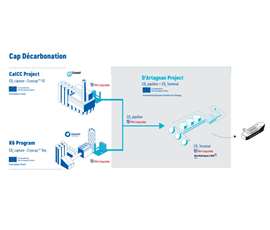CO2 infrastructure project gets EU support
19 June 2024
CO₂ transportation and exportation infrastructure is part of the “Cap Décarbonation” initiative

Air Liquide and Dunkerque LNG say their CO₂ infrastructure project took a major step forward with support from the European Union.
The CO₂ transportation and exportation infrastructure is part of the “Cap Décarbonation” initiative, which aims to reduce CO₂ emissions by 1.5 million tonnes each year in the industrial basin of Dunkirk and its surroundings. The D’Artagnan project will include an Air Liquide pipeline to transport CO₂ from the sites of capture as well as a terminal located in the port of Dunkirk to liquefy and load CO₂ on ships. The first CO₂ infrastructure project in France to receive support from the European Union, D’Artagnan would benefit from a grant of more than 160 million euros as part of the CEF-E (Connecting Europe Facility for Energy) funding program if the project is implemented.
D’Artagnan is the central link of a complete value chain - the “Cap Décarbonation” initiative - which is composed of complementary projects:
- CO₂ capture at Eqiom (cement plant in Lumbres, North of France) and Lhoist (lime production in Réty, North of France), through the implementation of Air Liquide’s Cryocap proprietary technology, benefiting from the Innovation Fund funding program.
- CO₂ transportation by pipelines and CO₂ exportation terminal - D’Artagnan project.
As part of the D’Artagnan project, the CO₂ captured would be transported by pipelines built and operated by Air Liquide to a new CO₂ terminal in the West Port of Dunkirk, in the proximity of the LNG terminal.
This new terminal, which would be built and operated by Air Liquide and Dunkerque LNG, would receive and liquefy CO₂, for shipment to permanent storage sites in the North Sea.
Designed to be open to industrial companies in the region for the transport and shipment of CO₂, this terminal would be able to receive 1.5 million tonnes per year, and, in the future, additional volumes of up to 4 million tonnes of CO₂ per year - equivalent to more than 5% of greenhouse gas emissions from industry in France. It would thus open the way to other CO₂ capture and sequestration projects in the Dunkirk basin.
D’Artagnan would represent an estimated investment of more than 400 million euros and would benefit from a grant of more than 160 million euros as part of the CEF-E (Connecting Europe Facility for Energy) funding program. The investment decision of the project will be linked in particular to the signing of CO₂ management and capture as a service contracts.
The first CO₂ infrastructure project in France to receive support from the European Union, D’Artagnan marks an essential step towards the implementation of the capture and sequestration technologies needed to reduce CO₂ emissions in France and Europe.
These technologies are crucial to significantly reduce CO₂ emissions from industrial sectors producing essential materials (such as cement and lime), whose emissions are in part difficult to reduce because they are inherent to the manufacturing process.
Image: D’artangnan
MAGAZINE
NEWSLETTER
CONNECT WITH THE TEAM






